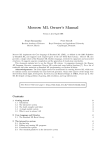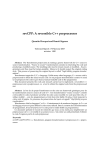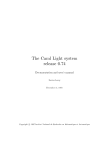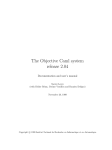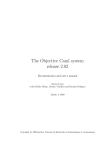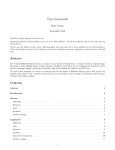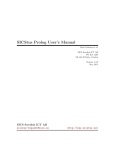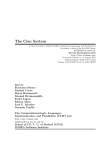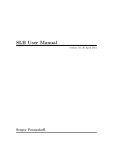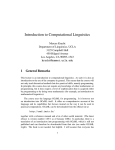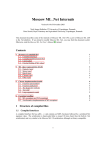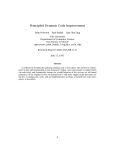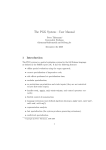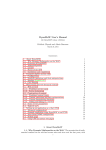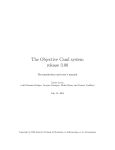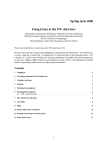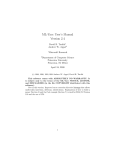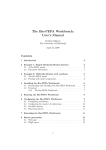Download Moscow ML Owner`s Manual
Transcript
Moscow ML Owner’s Manual
Version 2.00 of June 2000
Sergei Romanenko, Russian Academy of Sciences, Moscow, Russia
Claudio Russo, Cambridge University, Cambridge, United Kingdom
Peter Sestoft, Royal Veterinary and Agricultural University, Copenhagen, Denmark
Moscow ML implements Standard ML (SML), as defined in the 1997 Definition of Standard ML, including the SML
Modules language and some extensions. Moreover, Moscow ML supports most required parts of the SML Basis Library.
It supports separate compilation and the generation of stand-alone executables.
This document explains how to use the Moscow ML system. A companion document, the Moscow ML Language
Overview, summarizes Moscow ML syntax and the most common built-in functions [9]. Another companion document,
the Moscow ML Library Documentation, describes in detail all Moscow ML library modules [10].
Contents
1
Getting started
1.1 Installation
1.2 The interactive system
1.3 The batch compiler and linker
1.4 The Moscow ML Modules language
1.5 What is new in release 2.00
3
3
3
3
3
3
2
Additional documentation
4
3
The interactive system: mosml
3.1 On-line help
3.2 Editing and running ML programs
3.3 Command-line options of mosml
3.4 Non-standard primitives in the interactive system
5
5
5
5
6
4
Understanding inferred types and signatures
9
5
Compilation units
5.1 Compiling, linking and loading units
5.2 Compiling existing SML programs that involve .sig files
5.3 Unit names and MS DOS/Windows/OS2 file names
10
10
10
11
6
Structure-mode compilation units
6.1 Basic concepts
6.2 Structure-mode units without explicit signature
6.3 Structure-mode units with explicit signature
12
12
12
12
7
Toplevel-mode compilation units
7.1 Basic concepts
13
13
8
An example program consisting of four mixed-mode units
14
9
Recompilation management using mosmldep and make
16
10 The batch compiler and linker: mosmlc
10.1 Overview
10.2 Command-line options of mosmlc
17
17
18
1
11 Extensions to the Standard ML Modules language
11.1 Higher-order modules
11.2 Applicative functors
11.3 Opaque and transparent functor signatures
11.4 First-class modules
11.5 Recursive structures and signatures
11.6 Miscellaneous relaxations of Standard ML restrictions
20
20
21
22
22
23
24
12 Value polymorphism
25
13 Weak pointers
26
14 Dynamic linking of foreign functions
26
15 Guide to selected dynamically loaded libraries
15.1 Using GNU gdbm persistent hash tables
15.2 Using POSIX regular expressions
15.3 Using the PostgreSQL relational database server
15.4 Using the MySQL relational database server
15.5 Using the PNG image library
15.6 Using the Socket interface
27
27
27
27
27
27
27
16 Quotations and antiquotations
28
17 A lexer generator: mosmllex
17.1 Overview
17.2 Hints on using mosmllex
17.3 Syntax of lexer definitions
17.3.1 Header section and entry points
17.3.2 Regular expressions
17.3.3 Actions
17.3.4 Character constants and string constants
29
29
29
29
29
30
31
31
18 A parser generator: mosmlyac
18.1 Overview
18.2 The format of grammar definitions
18.2.1 Header and trailer
18.2.2 Declarations
18.2.3 The format of grammar rules
18.3 Command-line options of mosmlyac
18.4 Reporting lexer and parser errors
32
32
32
32
32
33
33
33
19 Copyright and credits
34
20 How to get Moscow ML
34
21 Books and other materials on Standard ML
35
The Moscow ML home page is http://www.dina.kvl.dk/~sestoft/mosml.html
2
1 Getting started
1.1 Installation
Get a copy of the Moscow ML system executables (see Section 20 for instructions) and unpack them in your home
directory (under Unix) or in directory C:\ (under MS Windows and DOS). This creates a directory mosml. Read the
file mosml/install.txt. This manual, as well as the Moscow ML Language Overview and the Moscow ML Library
Documentation, are in directory mosml/doc.
1.2 The interactive system
The interactive system is invoked by typing mosml at the shell prompt. It allows you to enter declarations and evaluate
expressions:
$ mosml
Moscow ML version 2.00 (June 2000)
Enter ‘quit();’ to quit.
- fun fac n = if n = 0 then 1 else n * fac (n-1);
> val fac = fn : int -> int
- fac 10;
> val it = 3628800 : int
You can quit the interactive session by typing ‘quit();’ or control-D (under Unix) or control-Z followed by newline (under MS Windows and DOS). Type help "lib"; for an overview of built-in function libraries, and e.g. help
"Array" for help on Array operations. See Section 3 for further information on mosml.
1.3 The batch compiler and linker
The batch compiler and linker is invoked by typing mosmlc at the shell prompt. It can compile ML source files separately
(mosmlc -c) and link them to obtain executables (mosmlc -o), in a manner similar to C compilers. See Section 10 for
further information on mosmlc.
1.4 The Moscow ML Modules language
The Moscow ML Modules language is a conservative extension of the Standard ML Modules language, so that any
Standard ML program can be compiled with Moscow ML 2.00, using toplevel-mode compilation; see Section 7.
Moreover, the Moscow ML Modules language is backwards compatible with Moscow ML versions 1.44 and before,
so that any existing Moscow ML program can be compiled with Moscow ML 2.00, using structure-mode compilation;
see Section 6.
1.5 What is new in release 2.00
The Moscow ML Modules language (designed and implemented by Claudio Russo) includes the full Standard
ML Modules language (structures, signatures, and functors):
The Moscow ML Modules language extends the Standard ML Modules language in three ways:
– higher-order functors: a functor may be defined within a structure, passed as an argument to another functor,
or returned as the result of a functor; see Sections 11.1, 11.2 and 11.3
– first-class modules: structures and functors may be packed and then handled as Core language values, which
may then be unpacked as structures or functors again; see Section 11.4
– recursive modules: structures and signatures may be recursively defined; see Section 11.5
Value polymorphism has become friendlier: non-generalizable free type variables are left free, and become instantiated (once only) when the bound variable is used; see Section 12.
Added facilities for creating and communicating with subprocesses (structure Unix and Signal from SML Basis
Library).
Added facilities for efficient functional generation of HTML code (structure Msp); also supports the writing of ML
Server Page scripts.
Added facilities setting and accessing ‘cookies’ in CGI scripts Mosmlcookie, thanks to Hans Molin.
The Gdimage structure now produces PNG images (using Thomas Boutell’s gd library).
3
Internal changes: restrictions on datatype constructor ordering have been removed; the runtime system and bytecode format now accommodate much larger programs; the representation of exceptions has been simplified; literals
are now shared inside topdecs; etc.
2 Additional documentation
Moscow ML implements Standard ML (SML) as revised in 1997, also known as SML’97 [7, 8], and some extensions
to the SML Modules language. Moscow ML implements much of the Standard ML Basis Library [3], the most important omission being the functional stream input-output operations. The Standard ML Basis Library is a joint effort of
the Standard ML of New Jersey, MLWorks, and Moscow ML developers1 to enhance the portability of Standard ML
programs.
The Moscow ML Language Overview [9] describes the Moscow ML source syntax, which is SML’97 with some
extensions, and the most common built-in functions.
The Moscow ML Library Documentation [10] describes in detail all Moscow ML library modules and has a comprehensive index to exceptions, functions, structures, types, and values. The same information is available also from
mosml’s built-in help function (Section 3.1) and as hypertext from Moscow ML’s homepage and in the file
mosml/doc/mosmllib/index.html.
The Moscow ML for the Apple Macintosh [2] is a detailed user guide to the Apple Macintosh version of Moscow
ML.
1 The Basis Library authors are Andrew Appel (Princeton, USA); Emden Gansner (AT&T Research, USA); John Reppy, Lal George, Lorenz
Huelsbergen, Dave MacQueen (Lucent Bell Laboratories, USA); Matthew Arcus, Dave Berry, Richard Brooksby, Nick Barnes, Brian Monahan, Jon
Thackray (Harlequin Ltd., Cambridge, England); Carsten Müller (Berlin, Germany); and Peter Sestoft (Royal Veterinary and Agricultural University,
Denmark).
4
3 The interactive system: mosml
The interactive system mosml is invoked simply by typing mosml at the command line:
$ mosml
Moscow ML version 2.00 (June 2000)
Enter ‘quit();’ to quit.
-
The interactive system can be terminated by typing quit(); and newline, or control-D (under Unix) or control-Z and
newline (under MS Windows and DOS). Type ‘help "";’ for help on built-in functions.
Invoking the interactive system with command line arguments
mosml file1 ... filen
is equivalent to invoking mosml and, when Moscow ML has started, entering
(use "file1 "; ...; use "filen ");
3.1 On-line help
In a mosml session, you may type help "lib"; for an overview of built-in function libraries. To get help on a particular
identifier, such as fromString, type
help "fromstring";
This will produce a menu of all library structures which contain the identifier fromstring (disregarding the lowercase/uppercase distinction):
-------------------------------|
1 | val Bool.fromString
|
|
2 | val Char.fromString
|
|
3 | val Date.fromString
|
|
4 | val Int.fromString
|
|
5 | val Path.fromString
|
|
6 | val Real.fromString
|
|
7 | val String.fromString |
|
8 | val Time.fromString
|
|
9 | val Word.fromString
|
| 10 | val Word8.fromString |
--------------------------------
Choosing a number from this menu will invoke the help browser on the desired structure, e.g. Int. The help browser is
primitive but easy to use. It works best with a window size of 24 lines.
3.2 Editing and running ML programs
Unix and Emacs You may run mosml as a subshell under Emacs. You should use the mosml-version of the SML mode
for Emacs; see file mosml/utility/emacs for instructions. In case of errors, Emacs can interpret mosml’s error
messages and jump to the offending piece of source code. This is very convenient.
Window systems In a window-oriented system, such as MacOS, MS Windows, or the X window system, you may run
mosml in one window and edit source code in another. After (re-)editing the source file, you must issue a use
command in the mosml window.
MS DOS and MS Windows You may use the simple edit script to invoke an editor from inside a mosml session; see
file mosml\utility\dosedit for instructions. You will not need to quit the mosml session to edit a source file,
and the script will automatically reload the newly edited file.
3.3 Command-line options of mosml
-conservative
Sets conservative mode for compilation of subsequent units: accept all extensions to the SML Modules language,
but issue a warning for each use; see Section 11. This is the default.
5
-I directory
Specifies directories to be searched for interface files, bytecode files, and source files. A call to use, load or
loadOne will first search the current directory, then all directories specified by option ‘-I’ in order of appearance
from left to right, and finally the standard library directory. (This option affects the variable Meta.loadPath; see
Section 3.4).
-imptypes
Specifies that the type checker should distinguish between imperative and applicative type variables, generalize
all applicative type variables, and generalize imperative type variables only in non-expansive expressions. See
Section 12.
-liberal
Sets liberal mode for compilation of subsequent units: accept without warnings all extensions to the SML Modules
language; see Section 11.
-orthodox
Sets orthodox mode for the compilation of subsequent units: reject all uses of the extensions to the SML Modules
language. That is, accept only SML Modules syntax; see Section 11.
-P unit-set
Determines which library units will be included and open at compile-time. Any library unit in the load path can be
used by the compile function for type checking purposes. Thus regardless of the -P option, the compile function
knows the type of library functions such as Array.foldl.
-P default The initial environment for the SML Basis Library: modules Array, Char, List, String, and
Vector will be loaded, and Char, List, and String will be partially opened.
-P sml90 This provides an initial environment which is upwards compatible with that of the 1990 Definition
of Standard ML and with pre-1.30 releases of Moscow ML. In particular, the functions chr, explode,
implode, and ord work on strings, not characters. The new versions of these functions are still available
as Char.chr, Char.ord, String.explode, and String.implode. The math functions and input-output
facilities required by the 1990 Definition [7, Appendix C and D] are available at top-level. In addition the
same libraries are loaded as with -P default.
-P nj93 This provides a top-level environment which is mostly compatible with that of SML/NJ 0.93. The
functions app, ceiling, chr, dec, explode, fold, hd, implode, inc, max, min, nth, nthtail, ord, ordof,
revapp, revfold, substring, tl, and truncate have the same type and meaning as in SML/NJ 0.93. Note
that this is incompatible with SML/NJ version 110. The math functions and input-output facilities required
by the 1990 Definition [7, Appendix C and D] are available at top-level. In addition the same (new) libraries
are loaded as with -P default. This option does not imply -imptypes.
-P full This loads all the libraries marked F in the library list (see [9]), and partially opens the Char, List, and
String units.
-P none No library units are loaded or opened initially.
Additional library units can loaded into the interactive system by using the load function; see Section 3.4 below.
-quietdec
Turns off the interactive system’s prompt and responses, except for warnings and error messages. Useful for
writing scripts in SML. Sets Meta.quietdec to true; see Section 3.4.
-stdlib stdlib-directory
Specify the standard library directory to be stdlib-directory. The default standard library is usually mosml/lib
under Unix and c:\mosml\lib under MS Windows and DOS.
-valuepoly
Specifies that the type checker should use ‘value polymorphism’; see Section 12. Default.
3.4 Non-standard primitives in the interactive system
The following non-standard primitives are defined in unit Meta, loaded (and open by default) only in the interactive
system. Hence these primitives cannot be used from source files which are compiled separately. The functions compile,
compileStructure, compileToplevel and load deal with Moscow ML compilation units; see Section 5.
compile : string -> unit
Evaluating compile "U.sig" will compile and elaborate the specifications in file U.sig in structure mode, producing a compiled signature U in file U.ui. This function is backwards compatible with Moscow ML 1.44 and earlier.
Equivalent to compileStructure [] "U.sig".
6
Evaluating compile "U.sml" will elaborate and compile the declarations in file U.sml in structure mode, producing a compiled structure U in bytecode file U.uo. If there is an explicit signature U.sig, then file U.ui must exist,
and the structure must match the signature. If there is no U.sig, then an inferred signature will be produced in
file U.ui. No evaluation takes place. This function is backwards compatible with Moscow ML 1.44 and earlier.
Equivalent to compileStructure [] "U.sml".
The declared identifiers will be reported if verbose is true (see below); otherwise compilation will be silent. In
any case, compilation warnings are reported, and compilation errors abort the compilation and raise the exception
Fail with a string argument.
compileStructure : string list -> string -> unit
Evaluating compileStructure opnunits "U.sig" will elaborate and compile the specifications in file U.sig in
structure mode, producing a compiled signature U in file U.ui. The units listed in opnunits are added to the
compilation context in which the specifications in U.sig are compiled.
Evaluating compileStructure opnunits "U.sml" will elaborate and compile the declarations in file U.sig in
structure mode, producing a compiled structure U in bytecode file U.uo. The contents of the units listed in
opnunits are added to the compilation context in which the declarations in U.sml are compiled. If there is an
explicit signature U.sig, then file U.ui must exist, and the structure must match the signature. If there is no U.sig,
then an inferred signature will be produced in file U.ui. No evaluation takes place.
compileToplevel : string list -> string -> unit
Evaluating compileToplevel opnunits "U.sig" will elaborate and compile the specifications in file U.sig in
toplevel mode, producing a compiled interface file U.ui. The units listed in opnunits are added to the compilation
context in which the specifications in U.sig are compiled.
Evaluating compileStructure opnunits "U.sml" will elaborate and compile the declarations in file U.sig in
toplevel mode, producing a bytecode file U.uo. The contents of the units listed in opnunits are added to the
compilation context in which the declarations in U.sml are compiled. If there is an explicit signature U.sig, then
file U.ui must exist, and declarations must match the interface. If there is no U.sig, then an inferred signature will
be produced in file U.ui. No evaluation takes place.
conservative : unit -> unit
Evaluating conservative () sets conservative mode for the compilation functions: accept all extensions to the
SML Modules language, but issue a warning for each use; see Section 11. The conservative mode may be set also
by the mosml option -conservative. Conservative mode is the default.
installPP : (ppstream -> ’a -> unit) -> unit
Evaluating installPP pp installs the prettyprinter pp at type ty, provided pp has type ppstream -> ty ->
unit. The type ty must be a nullary (parameter-less) type constructor, either built-in (such as int or bool) or
user-defined. Whenever a value of type ty is about to be printed by the interactive system, and whenever function
printVal is invoked on an argument of type ty, the prettyprinter pp will be invoked to print it. See the example
in mosml/examples/pretty.
liberal : unit -> unit
Evaluating liberal () sets liberal mode for the compilation functions: accept (without warnings) all extensions
to the SML Modules language; see Section 11. The liberal mode may be set also by the mosml option -liberal.
load : string -> unit
Evaluating load "U" will load and evaluate the compiled unit implementation from file U.uo. The resulting
values are not reported, but exceptions are reported, and cause evaluation and loading to stop. If U is already
loaded, then load "U" has no effect. If any other unit is mentioned by U but not yet loaded, then it will be loaded
automatically before U. The loaded unit(s) must be in the current directory or in a directory on the loadPath list
(see below).
After loading a unit, it can be opened with open U. Opening it at top-level will list the identifiers declared in the
unit.
When loading U, it is checked that the interfaces of units mentioned by U agree with the interfaces used when
compiling U, and it is checked that the interface of U has not been modified since U was compiled; these checks
are necessary for type safety. The exception Fail is raised if the interface checks fail, or if the file containing U
or a unit mentioned by U is not found.
loaded : unit -> string list
Evaluating loaded () will return a list of the names of loaded units in some order (not including the preloaded
units Meta and General).
loadOne : string -> unit
Evaluating loadOne "U" is similar to load "U", but raises exception Fail if U is already loaded or if some unit
mentioned by U is not yet loaded. That is, it does not automatically load any units mentioned by U. It performs
7
the same interface checks as load.
loadPath : string list ref
This variable determines the load path: which directories will be searched for interface files (.ui files), bytecode
files (.uo files), and source files (.sml files). This variable affects the load, loadOne, and use functions. The
current directory is always searched first, followed by the directories in loadPath, in order. By default, only
the standard library directory is in the list, but if additional directories are specified using option -I, then these
directories are prepended to Meta.loadPath.
orthodox : unit -> unit
Evaluating orthodox () sets orthodox mode for the compilation functions: reject all uses of the extensions to the
SML Modules language; see Section 11. That is, accept only SML Modules syntax. The orthodox mode may be
set also by the mosml option -orthodox.
printVal : ’a -> ’a
This is a polymorphic function provided as a quick debugging aid. It is an identity function, which as a side-effect
prints its argument to standard output exactly as it would be printed at top-level. Output is flushed immediately.
For printing strings, the function print is more useful than printVal.
printDepth : int ref
This variable determines the depth (in terms of nested constructors, records, tuples, lists, and vectors) to which
values are printed by the top-level value printer and the function printVal. The components of the value whose
depth is greater than printDepth are printed as ‘#’. The initial value of printDepth is 20.
printLength : int ref
This variable determines the depth to which list values are printed by the top-level value printer and the function
printVal. Only the first printLength elements of a list are printed, and the remaining elements are printed as
‘. . . ’. The initial value of printLength is 200.
quietdec : bool ref
This variable, when true, turns off the interactive system’s prompt and responses, except warnings and error
messages. Useful for writing scripts in SML. The default value is false; it can be set to true with the -quietdec
command line option; see Section 3.3.
quit : unit -> unit
Evaluating quit() quits Moscow ML immediately.
quotation : bool ref
Determines whether quotations and antiquotations are permitted in declarations entered at top-level and in files
compiled with compile; see Section 16. When quotation is false (the default), the backquote character is
an ordinary symbol which can be used in ML symbolic identifiers. When quotation is true, the backquote
character is illegal in symbolic identifiers, and a quotation ‘a b c‘ will be evaluated to an object of type ’a frag
list.
system : string -> int
Evaluating system "com" causes the command com to be executed by the operating system. If a non-zero integer
is returned, this must indicate that the operating system has failed to execute the command. Under MS DOS, the
integer returned always equals 0.
use : string -> unit
Evaluating use " f " causes ML declarations to be read from file f as if they were entered from the console. The
file must be in the current directory or in a directory on the loadPath list. A file loaded by use may, in turn,
evaluate calls to use. For best results, use use only at top level, or at top level within a use’d file.
valuepoly : bool ref
Determines whether the type checker should use ‘value polymorphism’; see Section 12. Command-line option
-valuepoly sets valuepoly to true (the default), whereas option -imptypes sets valuepoly to false; see
Sections 3.3 and 10.2.
verbose : bool ref
Determines whether the signature inferred by a call to compile will be printed. The printed signature follows the
syntax of Moscow ML signatures, so the output of compile "U.sml" can be edited to subsequently create file
U.sig. The default value is false.
8
4 Understanding inferred types and signatures
When you enter a declaration in the interactive toplevel, mosml responds with a type or signature. The response provides
much information about the declaration. It is worth learning how to interpret this information.
In the type reported for a value binding, the generalized type variables are listed between the val keyword and the
identifier bound by the declaration:
- val f = length;
> val ’a f = fn : ’a list -> int
— polymorphic function; ’a has been generalized
When value polymorphism (see Section 12) prevents the generalization of a type variable, it remains free and ungeneralized. Hence ’a will appear in the type ’a list -> int, but will not be listed between val and f.
For a datatype declaration, which is generative, the response describes the new internal type names (here u), the
datatype’s type structure (consisting of the internal type name and the constructors), and the constructors:
- datatype u = A;
> New type names: =u
datatype u = (u,{con A : u})
con A = A : u
The notation =u means that the internal type name u admits equality. Since the datatype declaration is generative,
repeated declaration of datatype u will produce distinct new internal type names u/1, u/2, etc. If the datatype is
polymorphic, the internal type name will be a type function, taking as parameter a type variable ’a:
- datatype ’a u =
> New type names:
datatype ’a u =
con ’a A = fn :
A of ’a;
=u
(’a u,{con ’a A : ’a -> ’a u})
’a -> ’a u
For a signature specifying an unknown type, the response is a type function /\t.{...} mapping any internal type name
t to a record {...}, which is the internal representation of the signature:
- signature SIG = sig type t val x : t end;
> signature SIG = /\t.{type t = t, val x : t}
For a structure declaration, the response describes any new internal type names, and then the internal signature of the
structure. Here it has three components (datatype t, constructor A, and value identifier x):
- structure S = struct datatype t = A; val x = A end;
> New type names: =t
structure S : {datatype t = (t,{con A : t}), con A : t, val x : t}
For a functor, the response describes a signature function {...}->{...}, mapping the signature of the functor argument
to the signature of the functor body:
- functor F(X : sig val x : int end) = struct val y = X.x end;
> functor F : {val x : int}->{val y : int}
When the functor argument signature specifies an unknown type, the signature function will have the form
!t.{...}->{...} in which the internal type name t has been generalized:
- functor F(X : sig type t; val x : t end) = struct val y = X.x end;
> functor F : !t.{type t = t, val x : t}->{val y : t}
When the body of a (standard) generative functor G contains a datatype declaration, the response describes what new
internal type names will be generated at every application of the functor. The notation {}->... means that the functor
argument signature is empty, and the notation ?=t.{...} says that there is some internal type name t, admitting equality,
such that the functor body has the signature {...}:
- functor F() = struct datatype t = A end;
> functor F : {}->?=t.{datatype t = (t,{con A : t}), con A : t}
When the functor is applicative (see Section 11.2) then no new internal type names are generated at functor application.
9
5 Compilation units
Moscow ML programs can be split into several source files, so-called compilation units, or units for short. A compilation
unit consists of an implementation file unitid.sml and an optional interface file unitid.sig. A unit must be compiled
in one of two modes:
Structure mode: File A.sml declares a single SML structure A, and file A.sig, if present, declares an explicit
SML signature A that is used as an opaque constraint for structure A.
Structure-mode units are backwards compatible with the simple structures used in Moscow ML version 1.20
through 1.44. Hence old Moscow ML programs can be compiled (in structure mode) with no changes.
To compile a unit in structure mode, use the function compileStructure (see Section 3.4), or invoke the batch
compiler mosmlc, preceding the unit file name with option -structure (see Section 10.2).
Toplevel mode: File A.sml contains a Moscow ML declaration (which may itself be a sequence of declarations),
and file A.sig, if present, must be a Moscow ML specification (which may itself be a sequence of specifications).
Toplevel-mode units can contain arbitrary Moscow ML code, and hence arbitrary Standard ML code.
To compile a unit in toplevel mode, use the function compileToplevel (see Section 3.4), or invoke the batch
compiler mosmlc, preceding the unit file name with option -toplevel (see Section 10.2).
The implementation file and the interface file (if any) of a unit must be compiled in the same mode. The precise syntax
of structure-mode units and toplevel-mode units is given in the Moscow ML Language Overview [9].
A programming project may consist of a mixture of structure-mode and toplevel-mode compilation units. See the
example in Section 8.
5.1 Compiling, linking and loading units
Compiling a unit interface A.sig produces a compiled unit interface in file A.ui. Compiling a unit implementation
A.sml produces a compiled unit implementation in file A.uo, containing bytecode. In addition, if there is no correspond
interface A.sig, then a file A.ui, containing an inferred unit interface, is produced.
Only the compiled unit interface A.ui is needed when compiling other units that depend on A.sml.
Thus the following file name extensions have a special meaning:
Extension
.sig
.sml
.ui
.uo
Contents
unit interface
unit implementation
compiled (or inferred) unit interface
compiled unit implementation (bytecode)
Compiled unit implementations can be linked together using mosmlc -o mosmlout A.uo ... to produce a linked
executable bytecode file mosmlout. The linker will automatically link in any required bytecode files into mosmlout. See
Section 10.2 for more options.
Compiled units can be loaded into the interactive system mosml using the primitives load and loadOne; see Section 3.4. Loading a unit makes the entities declared by the unit accessible to subsequent declarations in the interactive
system.
5.2 Compiling existing SML programs that involve .sig files
The special meaning of .sig files may cause conflicts when compiling existing SML programs (written for other compilers), in which .sig files are often used rather informally to contain signature declarations. For instance, file A.sig may
declare the signatures of structures declared in file A.sml (but might contain other arbitrary SML declarations besides).
By contrast, in Moscow ML, .sig files play a formal role. More precisely, Moscow ML expects file A.sig to contain a
unit interface. Thus it may be necessary to rename A.sig to A-sig.sml, compile it before A.sml, and make its contents
available to A.sml (see also Section 7):
mosmlc -c -toplevel A-sig.sml
mosmlc -c -toplevel A-sig.ui A.sml
10
5.3 Unit names and MS DOS/Windows/OS2 file names
In MS DOS, Windows, and OS/2, the file system may change the case of unit file names, and even truncate them (in MS
DOS). Under MS Windows, file names are not truly case sensitive. Since file names are used as unit names, this may
cause problems. We attempt to circumvent these problems as follows:
Unit names used inside ML programs under MS DOS and MS Windows are ‘normalized’: the first character is
made upper case (if it is a letter), all other characters are made lower case, and (under MS DOS only) the unit
name is truncated to eight characters. Hence a unit which resides in file commands.sml can be referred to as unit
Commands inside an ML program.
The following names are exceptions to this rule: BasicIO, BinIO, CharArray, CharVector,
CommandLine, FileSys, ListPair, OS, StringCvt, Substring, TextIO, Word8Array, Word8Vector; they are
normalized precisely as shown above for compatibility with the SML Basis Library.
Under MS DOS (only), a unit name given as argument to e.g. load or compile, or to the batch compiler, is
truncated and made lower case, so evaluating load "VeryLongName" will load bytecode file verylong.uo.
11
6 Structure-mode compilation units
This section describes the use of structure-mode compilation units, which are backwards compatible with Moscow ML
versions 1.20 through 1.44.
6.1 Basic concepts
A structure-mode compilation unit consists of a unit implementation, in file unitid.sml, and an optional unit interface,
in file unitid.sig.
The file unitid.sml must contain a declaration of a single Moscow ML structure unitid, and file unitid.sig,
if present, must contain a declaration of a single Moscow ML signature unitid. When the unit interface is present, it
is called the explicit signature to distinguish it from the signature inferred when elaborating the unit implementation.
When present, the explicit signature must be matched by the implementation, and only those identifiers specified in the
signature are visible outside the unit.
For a structure-mode unit it is immaterial whether a compilation unit’s interface and implementation are compiled
and directly executed in the interactive toplevel system:
mosml
> use "unitid.sig";
> use "unitid.sml";
or whether they are first compiled in structure-mode, and then loaded into the interactive toplevel system:
mosmlc -c -structure unitid.sig unitid.sml
mosml
> load "unitid";
where unitid.sig, if present, must be compiled before unitid.sml.
More generally, when a compilation unit depends on a number of other compilation units "unitid1 ",. . . ,"unitidn ",
then compilation inside the interactive system:
mosml
> app load ["unitid1 ",...,"unitidn "];
> use "unitid.sig";
> use "unitid.sml";
is equivalent to structure-mode compilation followed by loading into the interactive system:
mosmlc -c -structure unitid1 .ui ... unitidn .ui unitid.sig unitid.sml
mosml
> app load ["unitid1 ",...,"unitidn "];
> load "unitid";
6.2 Structure-mode units without explicit signature
A unit U without an explicit signature consists of a file U.sml containing
structure U = modexp
This is the same as a simple SML structure declaration. There must be no corresponding explicit signature file U.sig.
6.3 Structure-mode units with explicit signature
A unit U with an explicit signature consists of a signature file U.sig containing
signature U = sigexp
and a file U.sml, containing
structure U :> U = modexp
This is similar to an SML structure declaration with an opaque signature constraint. Note that the file name, signature
name, and structure name must be the same. The notation ‘U :> U’ is an opaque signature constraint, meaning that
other units have no access to the internals of U.sml, only to the signature U.sig.
12
7 Toplevel-mode compilation units
A toplevel-mode compilation unit may contain arbitrary Moscow ML toplevel declarations, and consequently, arbitrary
Standard ML toplevel declarations (including functor, signature and fixity declarations).
7.1 Basic concepts
A toplevel-mode compilation unit consists of a unit implementation, in file unitid.sml, and an optional unit interface,
in a file called unitid.sig.
The file unitid.sml may contain arbitrary Moscow ML declarations, and file unitid.sig, if present, may contain
arbitrary Moscow ML specifications. When the unit interface is present, the unit implementation must implement everything specified in the unit interface, and only those identifiers specified in the interface are visible outside the unit.
It is considered a mistake for the implementation to declare more identifiers than specified in the interface or for the
implementation to declare an identifier as a constructor or exception, but the interface to specify that identifier as an
ordinary value: a warning is issued in these cases.
Provided the interface and implementation agree on which identifiers are declared, then it is immaterial whether a
compilation unit is compiled and directly executed in the interactive toplevel system:
mosml
> use "unitid.sml";
or whether it is first compiled in toplevel-mode, and then loaded into the interactive system:
mosmlc -c -toplevel unitid.sig unitid.sml
mosml
> load "unitid";
In contrast to a structure-mode unit, the unit interface unitid.sig should not be loaded in the interactive system, as it
declares nothing. If there is no unitid.sig, then leave it out in the mosmlc command above.
More generally, when a toplevel compilation unit depends on a number of other compilation units "unitid1 ", . . . ,
"unitidn " (compiled in structure mode or toplevel mode), then compilation inside the interactive system:
mosml
> app load ["unitid1 ",...,"unitidn "];
> use "unitid.sml";
is equivalent to toplevel-mode compilation followed by loading into the interactive system:
mosmlc -c -toplevel unitid1 .ui ... unitidn .ui unitid.sig unitid.sml
mosml
> app load ["unitid1 ",...,"unitidn "];
> load "unitid";
Again, if there is no unitid.sig, then leave it out in the mosmlc command above.
13
8 An example program consisting of four mixed-mode units
To illustrate units, we present a tiny program working with arithmetic expressions. It consists of two structure-mode
units, Expr and Reduce and two toplevel-mode units, Evaluate and Test. This example is in mosml/examples/units.
File Expr.sml below is a structure-mode unit implementation that contains structure Expr which defines a datatype
expr for representing expressions and a function show to display them. It has no signature constraint and therefore
exports both the datatype and the function:
structure Expr = struct
datatype expr = Cst of int | Neg of expr | Plus of expr * expr
fun show (Cst n)
= makestring n
| show (Neg e)
= "(-" ^ show e ^ ")"
| show (Plus (e1, e2)) = "(" ^ show e1 ^ "+" ^ show e2 ^ ")"
end
File Reduce.sig below is a structure-mode unit interface that contains the signature Reduce:
signature Reduce = sig
val reduce : Expr.expr -> Expr.expr
end
File Reduce.sml below is a structure-mode unit implementation that declares the structure Reduce, with the explicit
signature shown above, and therefore exports only the function reduce specified in that signature:
structure Reduce :> Reduce = struct
local open Expr
in
fun negate (Neg e) = e
| negate e
= Neg e
fun reduce (Neg (Neg e))
| reduce (Neg e)
| reduce (Plus (Cst 0, e2))
| reduce (Plus (e1, Cst 0))
| reduce (Plus (e1, e2))
| reduce e
end
end
=
=
=
=
=
=
e
negate (reduce e)
reduce e2
reduce e1
Plus (reduce e1, reduce e2)
e
File Evaluate.sig below is a toplevel-mode unit interface that contains the specification of a functor Eval, which
maps any structure R matching the signature Reduce to a structure with a function eval for evaluating expressions, and
a function test for testing R:
functor Eval : functor(R:Reduce) ->
sig val eval: Expr.expr -> int
val test: Expr.expr -> bool
end
File Evaluate.sml below is a toplevel-mode unit implementation that contains the actual functor Eval, which mentions
the unit Expr as well as well as the unit interface Reduce:
functor Eval(R:Reduce) =
struct
local open Expr in
fun eval (Cst n)
= n
| eval (Neg e)
= ~ (eval e)
| eval (Plus (e1, e2)) = eval e1 + eval e2;
fun test e = (eval e = eval (R.reduce e))
end
end
File Test.sml is a toplevel-mode unit implementation which mentions the unit Expr, the unit Reduce, and the functor
Eval defined in the unit Evaluate, applies the functor to Reduce and carries out two tests:
14
structure T = Eval(Reduce)
open Expr
val t1 = T.test (Plus (Cst 244, Cst 0))
val t2 = T.test (Neg (Plus (Neg (Cst 140), Cst 0)))
The simplest way to compile this example is to enter:
mosmlc -c -structure Expr.sml Reduce.sig Reduce.sml -toplevel Evaluate.sig Evaluate.sml
Test.sml
which is equivalent to issuing the following individual commands:
mosmlc
mosmlc
mosmlc
mosmlc
mosmlc
mosmlc
-c
-c
-c
-c
-c
-c
-structure Expr.sml
-structure Expr.ui Reduce.sig
-structure Expr.ui Reduce.sml
-toplevel Expr.ui Reduce.ui Evaluate.sig
-toplevel Expr.ui Reduce.ui Evaluate.sml
-toplevel Expr.ui Reduce.ui Evaluate.ui Test.sml
The above command (re)compiles all files unconditionally. However, when modifying a program consisting of several
units, it suffices to recompile just those units that have changed, and those units that depend on units that have changed.
Moreover, compilation uses only the interfaces of other units, so it suffices to recompile just those units that depend on
unit interfaces that have changed.
Thus if Expr.sml but not Expr.sig changes, it suffices to recompile just Expr.sml, not the units Reduce, Evaluate,
or Test. Similarly, if Reduce.sml but not Reduce.sig changes, it suffices to recompile just Reduce.sml, not the units
Evaluate or Test.
The next section explains recompilation management using mosmldep and make.
15
9 Recompilation management using mosmldep and make
Recompilation management helps the programmer recompile only what is necessary after a change to a unit interface or
unit implementation.
Consider the example program in Section 8 consisting of the four units Expr, Reduce, Evaluate and Test. Assume
their source files *.sig and *.sml reside in a particular directory (you may copy them from mosml/examples/units).
Copy the Makefile stub from mosml/tools/Makefile.stub to that directory, and change to that directory.
1. Edit the Makefile so that the names of the units Expr, Reduce, Evaluate, and Test appear on the line beginning
with ‘UNITS=’, with each unit preceded by the option -structure (the default) or -toplevel to indicate its mode
(see the example makefile in mosml/examples/units/Makefile):
UNITS= -structure Expr Reduce -toplevel Evaluate Test
2. Edit the Makefile so that the names of the compiled unit implementation files Expr.uo, Evaluate.uo, Reduce.uo
and Test.uo appear on the line beginning with ‘all:’:
all: Expr.uo Reduce.uo Evaluate.uo Test.uo
3. Compute the dependencies among the files by executing:
make depend
4. Recompile all those files which have not yet been compiled, or which have been modified but not yet recompiled,
or which depend on modified files, by executing:
make
Step (4) must be repeated whenever you have modified a component of the program system. Step (3) need only be
repeated if the inter-dependencies of some components change, or if you add or remove an explicit signature file. Steps
(2 and 1) need only be repeated when you add, delete or change the mode of an entire unit in the program system.
The compiled *.ui and *.uo files can be removed by executing:
make clean
The unit dependencies are computed by the ML program mosmldep, called with
mosmldep $(UNITS)
When you explicitly list the units (together with the indication of their compilation mode):
UNITS= -structure Expr Reduce -toplevel Evaluate Test
then mosmldep merely constructs a dependency file on the assumption that a unit may depend on all preceding units (to
the left), taking into account the presence of explicit interfaces (.sig files). Unfortunately, this means that mosmldep will
generally create an inefficient Makefile, containing more dependencies than are actually in your source files. However,
it still saves some recompilation (which is cheap in Moscow ML anyway) and is more convenient than hand-crafting
the Makefile. We hope to improve on this situation in the future, but computing dependencies for full Standard ML
programs is known to be difficult.
If you omit step (1) and leave $(UNITS) undefined:
UNITS=
then mosmldep will accurately infer the dependencies between all the .sig and .sml source files in the directory by
inspecting their contents and looking for occurrences of unit names. Unfortunately, this process only works for programs
containing just structure-mode units, that themselves contain only flat structures, but no functors or sub-structures. This
is the behaviour of mosmldep in releases of Moscow ML prior to 2.00, and is provided for backwards compatibility.
16
10 The batch compiler and linker: mosmlc
Moscow ML includes a batch compiler and linker mosmlc in addition to the interactive system mosml. It compiles units
and links programs, and can turn them into standalone executable bytecode files. The batch compiler can be invoked
from a Makefile (see Section 9), which simplifies the (re)compilation of large programs considerably.
10.1
Overview
The mosmlc command has a command-line interface similar to that of most C compilers. It accepts several types of
arguments: source files for unit interfaces, source files for unit implementations, compiled unit interfaces (which are
added to the compilation context), and compiled unit implementations (which are added to the linked executable).
An argument ending in .sig is taken to be the name of a source file containing a unit interface. Given a file U.sig,
the compiler produces a compiled interface in the file U.ui.
An argument ending in .sml is taken to be the name of a source file containing a unit implementation. Given a file
U.sml, the compiler produces compiled object code in the file U.uo. It also produces an inferred interface file U.ui
if there is no explicit interface U.sig.
An argument ending in .ui is taken to be the name of a compilation unit interface. The contents of that compilation
unit are added to the compilation context of the remaining source files.
An argument ending in .uo is taken to be the name of a compiled unit implementation. Such files are linked
together, along with the compiled unit implementations obtained by compiling .sml arguments (if any), and the
necessary Moscow ML library files, to produce a standalone executable program.
The linker automatically includes any additional bytecode files required by the files specified on the command
line; option -i makes it report all the files that were linked. The linker issues a warning if a file B is required by a
file A that precedes B in the command line. At run-time, the top-level declarations of the files are evaluated in the
order in which the files were linked; in the absence of any warning, this is the order of the .uo and .sml files on the
command line.
The linker (and the load function in the interactive toplevel) ensure probabilistically type-safe linking, so it is
virtually impossible to cause the system to create a type-unsafe program.
The output of the linking phase is a file containing compiled code that can be executed by the runtime system camlrunm.
If mosmlout is the name of the file produced by the linking phase (with option -o mosmlout), the command
mosmlout arg1 arg2 ... argn
executes the compiled code contained in mosmlout. Executing the code means executing the toplevel declarations of all
the bytecode files involved, in the order in which they were linked. The list of command-line arguments arg1 ... argn
can be obtained in a program by CommandLine.arguments ().
There is no distinguished function which is automatically invoked when the program is executed, but it is common
to define a main function and invoke it using the toplevel declaration val _ = main(), like this:
fun main () =
case CommandLine.arguments () of
[arg] => print ("The argument is " ^ arg ^ "\n")
| _
=> print "Usage: mosmlout arg\n\n"
val _ = main ();
MS Windows and DOS: If the output file produced by the linking phase has extension .exe, and option -noheader is
not used, then the file is directly executable. Hence, an output file named mosmlout.exe can be executed with the
command
mosmlout arg1 arg2 ... argn
The output file mosmlout.exe consists of a tiny executable file prepended to a linked bytecode file. The executable
invokes the camlrunm runtime system to interpret the bytecode. As a consequence, this is not a standalone
executable: it still requires camlrt.dll to be present in directory C:\mosml\bin.
Unix: The output file produced by the linking phase is directly executable (unless the -noheader option is used). It
automatically invokes the camlrunm runtime system, either using a tiny executable prepended to the linked bytecode file, or using the Unix incantation #!/usr/local/bin/camlrunm or similar. In the former case, camlrunm
must be in one of the directories in the path; in the latter case it must be in /usr/local/bin. To create a true
stand-alone executable, use mosmlc option -standalone.
17
10.2
Command-line options of mosmlc
The following command-line options are recognized by mosmlc.
-c
Compile only. Suppresses the linking phase of the compilation. Source code files are turned into compiled files
(.ui and .uo), but no executable file is produced. This option is useful for compiling separate units.
-conservative
Sets conservative mode for compilation of subsequent units: accept all extensions to the SML Modules language,
but issue a warning for each use; see Section 11. This is the default.
-files response-file
Pass the names of files listed in file response-file to the linking phase just as if these names appeared on the
command line. File names in response-file are separated by blanks (spaces, tabs, newlines) and must end either in
.sml or .uo. A name U.sml appearing in the response file is equivalent to U.uo. Use this option to overcome silly
limitations on the length of the command line (as in MS DOS).
-g
This option causes some information about exception names to be written at the end of the executable bytecode
file.
-i
Causes the compiler to print the inferred interface(s) of the unit implementation(s) being compiled. Also causes
the linker to list all object files linked. A U.sig file corresponding to a given U.sml file can be produced semiautomatically by piping the output of the compiler to a file U.out, and subsequently editing this file to obtain a file
U.sig.
-I directory
Add the given directory to the list of directories searched for compiled interface files (.ui) and compiled implementation files (.uo). By default, the current directory is searched first, then the standard library directory. Directories
added with -I are searched after the current directory, but before the standard library directory. When several
directories are added with several -I options on the command line, these directories are searched from left to
right.
-imptypes
Specify that the type checker should distinguish imperative and applicative type variables, generalize all applicative type variables, and generalize imperative type variables only in non-expansive expressions. See Section 12.
-liberal
Sets liberal mode for compilation of subsequent units: accept without warnings all extensions to the SML Modules
language; see Section 11.
-msgstyle style
By specifying -msgstyle msdev, one can make the compiler generate error messages understandable by Microsoft Developer Studio. The default behaviour is to generate error messages understandable the Emacs editor in
SML mode.
-noautolink
The linker automatically links in any additional object files required by the files explicitly specified on the command line. With option -noautolink all required object files must be explicitly specified in the appropriate order.
-noheader
Causes the output file produced by the linker to contain only the bytecode, not preceded by any executable code. A
file mosmlout thus obtained can be executed only by explicitly invoking the runtime system as follows: camlrunm
mosmlout.
-o exec-file
Specify the name of the output file produced by the linker. In the absence of this option, a default name is used.
In MS Windows and DOS, the default name is mosmlout.exe; in Unix it is a.out.
-orthodox
Sets orthodox mode for the compilation of subsequent units: reject all uses of the extensions to the SML Modules
language. That is, accept only SML Modules syntax; see Section 11.
-P unit-set
Determines which library units will be open at compile-time. Any library unit in the load path can be used by the
compiler for type checking purposes. Thus regardless of the -P option, the compiler knows the type of library
functions such as Array.foldl.
-P default The units Char, List, and String will be partially opened. This is the default, permitting e.g.
String.concat to be referred to just as concat.
18
-P sml90 Provides an initial environment which is upwards compatible with that of the 1990 Definition of Standard ML and with pre-1.30 releases of Moscow ML. In particular, the functions chr, explode, implode,
and ord work on strings, not characters. The math functions and input-output facilities required by the 1990
Definition [7, Appendix C and D] are available at top-level. In addition the same (new) libraries are opened
as with -P default.
-P nj93 Provides a top-level environment which is mostly compatible with that of SML/NJ 0.93. The functions
app, ceiling, chr, dec, explode, fold, hd, implode, inc, max, min, nth, nthtail, ord, ordof, revapp,
revfold, substring, tl, and truncate have the same type and meaning as in SML/NJ 0.93. The math
functions and input-output facilities required by the 1990 Definition [7, Appendix C and D] are available at
top-level. In addition the same (new) libraries are opened as with -P default. This option does not imply
-imptypes.
-P full Same as -P default.
-P none No library units are initially opened.
Additional directories to be searched for library units can be specified with the -I directory option.
-q
Enables the quotation/antiquotation mechanism; see Section 16.
-standalone
Unix: Specifies that the runtime system should be prepended to the linked bytecode, thus creating a stand-alone
executable. This adds 75–100 KB to the size of the linked file. MS Windows: This option cannot be used. Under
MS Windows, all mosmlc-generated executables require the dynamically linked library camlrt.dll to be present
in the directory C:\mosml\bin.
-stdlib stdlib-directory
Specifies the standard library directory, which will be searched by the compiler and linker for the .ui and .uo files
corresponding to units mentioned in the files being linked. The default standard library is set when the system is
created, and is usually ${HOME}/mosml/lib under Unix and c:\mosml\lib under MS Windows and DOS.
-structure
Specifies that subsequent .sml and .sig source files must be compiled in structure mode; see Section 6. Default.
-toplevel
Specifies that subsequent .sml and .sig source files must be compiled in toplevel mode; see Section 7.
-v
Prints the version number of the various passes of the compiler.
-valuepoly
Specify that the type checker should use ‘value polymorphism’; see Section 12. Default.
19
11 Extensions to the Standard ML Modules language
The Moscow ML Modules language extends the Standard ML Modules language in several ways:
higher-order functors: a functor may be defined within a structure, passed as an argument to another functor, or
returned as the result of a functor; see Section 11.1
applicative as well as (the usual) generative functors; see Section 11.2
transparent as well as opaque functor signatures; see Section 11.3
first-class modules: structures and functors may be packed and then handled as Core language values, which may
then be unpacked as structures or functors again; see Section 11.4
recursive modules: structures and signatures may be recursively defined; see Section 11.5
relaxation of miscellaneous Standard ML restrictions; see Section 11.6.
The Moscow ML Language Overview defines the precise syntax of the extensions. For some additional examples of their
use, see the directory mosml/examples/modules and its README file.
By default, Moscow ML accepts all non-Standard ML extensions, but issues a warning at every use. This is the
behaviour of Moscow ML’s conservative compilation mode. Two other compilation modes are available: liberal, in
which all extensions are silently accepted, and orthodox, in which all extensions are rejected as errors.
The compilation mode can be set by the command-line options -conservative, -liberal, and -orthodox; see
Sections 3.3 and 10.2. In the interactive system mosml, the compilation mode affects ML code entered interactively, as
well as the functions compile, compileStructure, compileToplevel, and use. The compilation mode can be set by
the functions conservative, liberal, and orthodox.
The extensions described here are based in part on [11, 12]; a formal definition of the extensions, derived from [7, 8],
is available on request.
11.1
Higher-order modules
In Standard ML Modules, structures and functor bodies cannot declare functors. In Moscow ML Modules, they can:
functor F1(S : sig type t; val x : t end) = struct
functor G(T : sig type u; val y : u end) = struct val pair = (S.x, T.y) end
end
structure R11 = F1(struct type t=int val x=177 end)
structure R12 = R11.G(struct type u=string val y="abc" end)
val (a, b) = R12.pair
A functor that returns a functor can be curried, avoiding the intermediate structure:
functor F2(S : sig type t; val x : t end) (T : sig type u; val y : u end) =
struct val pair = (S.x, T.y) end
structure R2 =
F2(struct type t=int val x=177 end)(struct type u=string val y="abc" end)
val (a, b) = R2.pair
A functor may be declared to take another functor as an argument, whose type is specified using a functor signature:
(* G is a functor signature *)
signature G = functor(X:sig type t=int val x: t end)->sig type u val y : u end
(* F3 takes the functor F as an argument, and applies it *)
functor F3(F:G) = F(struct type t=int val x=177 end)
(* R3 is the result of F3 applied to an anonymous functor *)
structure R3 = F3(functor(X:sig type t=int val x:t end)=>
struct type u = X.t * X.t val y= (X.x,X.x) end)
In the definition of R3, the argument to F3 happens to be an anonymous functor.
Wherever a functor of a certain type is expected, one may supply instead a functor that has more a general type, that is,
one which is more polymorphic, expects a less general argument, or produces a more general result:
(* F3 is applied to a more general functor than it specifically requires *)
structure R4 = F3(functor(X:sig type t end)=>
struct type u = X.t val y = 1 val z = [] end)
20
As in Standard ML, functors and structures reside in separate name spaces, so it is perfectly legal to re-use the same
name for both a structure and a functor, without one hiding the other:
structure M = struct end
functor M() = struct end
structure N1 = M
functor
N2 = M
structure N3 = M(M)
(* structure N1 bound to structure M *)
(* functor N1 bound to functor M *)
(* functor M applied to structure M *)
However, when another functor, say P, simply returns the identifier M, as in:
functor P () = M
it is not clear whether M refers to the structure M or the functor M. In this ambiguous case, Moscow ML always interprets
M, on its own, as a structure, but you can write op M to refer to the functor M instead:
functor P () = M
functor Q () = op M
(* P returns the structure M *)
(* Q returns the functor M *)
The files mosml/examples/modules/{poly.sml,bootstrap.sml} contain examples that use higher-order functors.
11.2
Applicative functors
In the Standard ML Modules language, all functors are generative. If the body of generative functor FG declares a
datatype or opaque type t, then two applications of FG will create two structures SG1 and SG2 with distinct types SG1.t
and SG2.t:
functor FG (S : sig end) = struct datatype t = C end
structure SG1 = FG() and SG2 = FG()
val res = if true then SG1.C else SG2.C;
(* generative
*)
(* ill-typed
*)
Recall that a conditional expression requires both branches to have equivalent types, so the last declaration above is
well-typed only if the type SG1.t is equivalent to SG2.t.
If functors had an applicative, not generative, semantics, the two types would be equivalent. Moscow ML Modules
allows the declaration of applicative functors2 as well as generative functors. An applicative version FA of the above
functor is declared the same way, except that the formal functor argument S : sig end is not enclosed in parentheses:
functor FA S : sig end = struct datatype t = C end
structure SA1 = FA() and SA2 = FA()
val res = if true then SA1.C else SA2.C;
(* applicative *)
(* well-typed
*)
More generally, if a type in an applicative functor’s body depends on a datatype or opaque type of the functor’s formal
argument, then the types returned by separate applications of the applicative functor will be equivalent, provided the
functor is applied to equivalent type arguments:
functor GA S : sig type t end = struct datatype u = C of S.t end
(* applicative, *)
(* but u depends on S.t *)
structure TA1 = GA(type t = int) and TA2 = GA(type t = bool) and TA3 = GA(type t = int)
val res = if true then TA1.C 1 else TA3.C 1;
(* well-typed *)
val res = if true then TA1.C 1 else TA2.C true;
(* ill-typed *)
Moscow ML supports type projections X.u (the dot notation for types) with local structure bindings. This makes it
possible to refer directly to a type returned by an applicative functor within another type expression, which is useful for
expressing sharing constraints:
signature S = sig functor F: functor X:sig type t end -> sig type u end
type v = X.u where X = F(type t = int)
(* X is local to X.u *)
end
The local binding has no run-time effect and is only elaborated at compile-time for its type information. For more
examples of applicative functors, see the files mosml/examples/modules/{collect.sml,bootstrap.sml}.
2
Similar to Objective Caml.
21
11.3
Opaque and transparent functor signatures
The types of functors are specified using functor signatures. Similar to the distinction between generative and applicative functor expressions, functor signatures may be opaque or transparent. Whether a functor signature is opaque or
transparent affects the interpretation of any datatype or opaque type specifications in its body signature:
The opaque functor signature
signature GO = functor(X:sig type t val x:t end)->sig type u val y:u end
(* opaque
*)
specifies the type of those functors that, when applied to an actual argument matching the argument signature sig
type t val x:t end, return a result matching the body signature sig type u val y:u end, for some unknown
implementation of the type u (possibly depending on X.t).
A transparent version GT of the above functor signature is written the same way, except that the formal functor
argument X:sig type t val x:t end is not enclosed in parentheses:
signature GT = functor X:sig type t val x:t end -> sig type u val y:u end
(* transparent *)
This functor signature specifies the family of functor types that, for a given implementation of the result type u (possibly
depending on X.t), map structures matching the argument signature sig type t val x:t end to structures matching
the body signature sig type u val y:u end.
In practice, when writing a functor H that takes a functor F as an argument, the choice between specifying that
argument using an opaque or transparent signature will affect the amount of type information that is propagated whenever
H is applied to an actual functor. For instance, consider the four functors:
functor F1 (X:sig type t val x:t end) = struct type u = X.t val y = X.x end
functor F2 (X:sig type t val x:t end) = struct type u = int val y = 1 end
functor HO(F:GO) = F(struct type t = string val x = "abc" end)
functor HT(F:GT) = F(struct type t = string val x = "abc" end)
Functor F1 returns a renamed version of its argument, and functor F2 just ignores its argument and returns the same
structure regardless. The two higher-order functors HO and HT apply the supplied F to the same argument (in which x is
a string), but assume, respectively, an opaque and a transparent signature for F.
Since functor HO uses the opaque signature GO, its formal argument F is assumed to return some new unknown type
u whenever it is applied, so that the two applications of HO return new abstract types RO1.u and RO2.u:
structure RO1 = HO(F1) and RO2 = HO(F2)
val resO1 = if true then RO1.y else "def";
val resO2 = if true then RO2.y else 1;
(* ill-typed *)
(* ill-typed *)
Functor HT, on the other hand, uses the transparent signature GT. This ensures that, no matter what the actual dependency
of result type u on argument type t, HT may be applied to any functor F whose argument signature and result signature
match GT, with the actual definition of u reflected in the result. In particular, the two applications of HT return the same
definitions for type u as would the substitution of F1 and F2 directly into the body of HT. That is, the types RT1.u and
RT2.u are equivalent to string and int:
structure RT1 = HT(F1) and RT2 = HT(F2)
val resT1 = if true then RT1.y else "def";
val resT2 = if true then RT2.y else 1;
(* well-typed *)
(* well-typed *)
Another way to look at this is that HO’s formal argument has a generative specification, so that its application in HO’s
body returns a new type, while HT’s formal argument has an applicative specification, so that its application in HT’s body
returns the same type as HT’s actual argument.
11.4
First-class modules
In the Moscow ML Modules language, a structure or functor can be wrapped up as a package, which is a first-class Core
language value just like any other value, and then subsequently unpacked to re-create the structure or functor:
22
signature NAT = sig type nat val Z:nat val S:nat -> nat val plus: nat -> nat -> nat end
structure SafeNat = (* unlimited range but slow *)
struct datatype nat = Z | S of nat fun plus Z m = m | plus (S n) m = S (plus n m) end
structure FastNat = (* limited range but fast *)
struct type nat = int val Z = 0 fun S n = n + 1 fun plus n m = n + m end
type natpack = [ NAT ]
val safeNat = [ structure SafeNat as NAT ];
val fastNat = [ structure FastNat as NAT ];
structure Nat as NAT =
if (913 mod 7 = 5) then safeNat else fastNat
val natlist = [safeNat,fastNat] : [ NAT ] list;
(* package type *)
(* packing
*)
(* unpacking
*)
A functor may be packed using the similar Core expression [ functor modexp as sigexp ] and unpacked using the
functor binding functor funid as sigexp = exp.
Package type equivalence is determined by structure, not name, so the following package types are equivalent:
[sig type t val x: t type u = t val y: u end]
[sig type u val x: u type t = u val y: t end]
because the signatures are equivalent (every structure that matches one also matches the other).
For type soundness reasons, a package may not be unpacked in the body of a functor (although it may be unpacked
within a Core expression occurring in that body):
functor Fail (val nat : [ NAT ]) =
struct structure Nat as NAT = nat end
(* illegal *)
functor Ok (val nat : [ NAT ]) =
struct val x = let structure Nat as NAT = nat in nat end end (* legal *)
The files mosml/examples/modules/{sieve.sml,array.sml,choice.sml,matrix.sml} contain more examples.
11.5
Recursive structures and signatures
The Standard ML Modules language does not permit recursively defined modules. For instance, two structures Even
and Odd may not depend on each other. In the Moscow ML Modules language, a structure may be defined recursively:
structure S = rec (X:sig structure Odd : sig val test
struct structure Even = struct fun test
| test
end
structure Odd = struct fun test
| test
end
end;
: int -> bool end end)
0 = true
n = X.Odd.test (n-1)
0 = false
n = Even.test (n-1)
Here, X is a forward declaration of the structure’s body that allows Even.test to refer to X.Odd.test before it has
been defined. The body of a recursive structure must match the signature of the forward declaration; any opaque type or
datatype specified in the signature must be implemented in the body by copying it using a forward reference:
structure Ok
= (* well-typed *)
rec (X:sig datatype
struct datatype t =
structure Fail = (* ill-typed *)
rec (X:sig datatype
struct datatype t =
t = C type u type v = int end)
datatype X.t type u = X.u type v = int end
t = C type u type v = int end)
C type u = int type v = int end
At run-time, attempting to evaluate the forward reference of a recursive structure before its body has been been fully
evaluated raises the exception Bind:
structure Fail = rec (X:sig end) X;
structure Fail = rec (X:sig val x: int end)
struct val x = X.x end;
structure Ok = rec (X:sig val f: int -> int end)
struct fun f n = X.f n end;
val res = Ok.f n
23
(* raises Bind
*)
(* raises Bind
*)
(* ok
*)
(* infinite loop *)
On their own, recursive structures cannot be used to declare mutually recursive datatypes that span module boundaries.
For this purpose, Moscow ML also supports recursive signatures:
signature REC = rec(X: sig structure Odd: sig type t end end)
sig structure Even: sig datatype t = Zero | Succ of X.Odd.t end
structure Odd: sig datatype t = One | Succ of Even.t end
end;
Here, X is a forward declaration of a structure implementing the body of the signature that allows the specification of
Even.t to refer to the type X.Odd.t before it has been fully specified. In a recursive signature, the body of the signature
must match the forward declaration and specify an implementation for any opaque types or datatypes declared within
the forward specification.
Once a recursive signature has been defined, it can be used to implement the recursive structure T with datatypes that
span module boundaries:
structure T = rec(X:REC)
struct structure Even = struct datatype
fun succ
| succ
end
structure Odd = struct datatype
fun succ
end
end
t = datatype X.Even.t
Zero = X.Odd.One
E = X.Odd.Succ E
t = datatype X.Odd.t
O = Even.Succ O
The files mosml/examples/modules/{recursion.sml,bootstrap.sml} contain examples of using recursive structures and signatures.
11.6
Miscellaneous relaxations of Standard ML restrictions
In Standard ML, functors and signatures may only be declared at top-level, and structures may only be declared at toplevel and within structures. None of these may be declared within Core let expressions. Moscow ML removes these
restrictions so that functors, signatures and structures may be declared anywhere, which is particularly useful when
programming with first-class modules.
In Standard ML, every parameterised type definition, and every type scheme occurring within a signature, must be
closed and must not mention any type variables that are not explicitly listed as parameters. Moscow ML does not impose
this restriction, and allows free type variables, provided they are bound in an enclosing scope. Again, this is useful when
programming with first-class modules.
type t = ’a -> ’a
(* illegal, since ’a not in scope
*)
fun f (x:’a) = let type t = ’a * ’a
in (x,x):t
end;
(* legal Mosml, illegal SML
*)
type ’a stackpack =
[ sig
type stack = ’a list;
val push : ’a -> stack -> stack
end ]
(* legal Mosml
*)
(* ’a occurs free in this type binding *)
(* ’a occurs free in this type scheme *)
24
12 Value polymorphism
The 1997 revision of Standard ML [8] adopts value polymorphism, discarding the distinction between imperative (’_a)
and applicative (’a) type variables, and generalizing type variables only in non-expansive expressions. In Moscow ML
2.00, non-generalized type variables are left free, to be instantiated later. Consider a val-binding
val x = e;
With value polymorphism, the free type variables in the type of x are generalized only if the right-hand side e is nonexpansive. This is a purely syntactic criterion: an expression is non-expansive if it has the form nexp, defined by the
grammar below:
nexp
::=
scon
longvid
{ nexprow }
( nexp )
con nexp
excon nexp
nexp : ty
fn match
[ structure nmodexp as sigexp ]
[ functor nmodexp as sigexp ]
special constant
(possibly qualified) value identifier
record of non-expansive expressions
parenthesized non-expansive expression
constructor application, where con is not ref
exception constructor application
typed non-expansive expression
function abstraction
structure package
functor package
nmodexp
::=
op longmodid
( nmodexp )
nmodexp :(:>) sigexp
functor arg => modexp
rec ( strid : sigexp ) nmodexp
module identifier
transparent (opaque) constraint
functor
recursive structure
nexprow
::=
lab = nexp , nexprow
Roughly, a non-expansive expression is just a value, that is, an expression in normal form. For example, the right-hand
side length below is an identifier, and so is non-expansive. Hence the free type variable ’a in the type ’a list ->
int of x becomes generalized, as shown by the occurrence of ’a between val and x:
- val x = length;
> val ’a x = fn : ’a list -> int
On the other hand, the right-hand side (fn f => f) length below, although it evaluates to the same value as the previous one, is expansive: it is not derivable from the above grammar. Hence the type variable ’a will not be generalized,
and a warning will be issued:
!
!
>
val x = (fn f => f) length;
Warning: Value polymorphism:
Free type variable(s) at top level in value identifier x
val x = fn : ’a list -> int
Note that the type variable ’a has not been generalized. Thus type variable ’a is free and may become instantiated when
x is used. If so, the type of x becomes more specific:
!
>
>
x ["abc", "def"];
Warning: the free type variable ’a has been instantiated to string
val it = 2 : int
x;
val it = fn : string list -> int
To make sure that a type variable gets generalized, one may eta-expand the right-hand side expression. Eta-expansion
replaces an expression e with fn y => (e y) thus making it non-expansive:
- val x1 = fn y => (fn f => f) length y;
> val ’b x1 = fn : ’b list -> int
Compatibility: All programs compiled with Moscow ML 1.44 will compile also with Moscow ML 2.00. To compile old
programs that use imperative type variables as in the 1990 Definition, you may invoke mosml or mosmlc with the option
-imptypes.
25
13 Weak pointers
Moscow ML supports weak pointers and arrays of weak pointers, using library structure Weak. A weak pointer is a
pointer that cannot itself keep an object alive. Hence the object pointed to by a weak pointer may be deallocated by the
garbage collector if the object is reachable only by weak pointers.
The interface to arrays of weak pointers is the same as that of standard arrays (structure Array), but the subscript
function sub may raise exception Fail if the accessed object is dead. On the other hand, if sub returns a value, it is
guaranteed not to die unexpectedly: it will be kept alive by the returned pointer. Also, the weak array iteration functions
iterate only over the live elements of the arrays.
One application of weak pointers is to implement hash consing without space leaks. The idea in hash consing is to
re-use pairs: whenever a new pair (a, b) is to be built, an auxiliary table is checked to see whether such a pair exists
already. If so, the old pair is reused. In some applications, this may conserve much space and time. However, there is a
danger of running out of memory because of a space leak: the pair (a, b) cannot be deallocated by the garbage collector
because it remains forever reachable from the auxiliary table. To circumvent this problem, one creates a weak pointer
from the auxiliary table to the pair, so that the auxiliary table in itself cannot keep the pair alive.
For an example, see mosml/examples/weak. See also the description of Weak in the Moscow ML Library Documentation, or try ‘help "Weak";’.
14 Dynamic linking of foreign functions
Moscow ML supports dynamic linking of foreign (C) functions, using library structure Dynlib3 . A library of functions
may be written in C and compiled into a dynamically loadable library, using appropriate compiler options. With the
Dynlib structure one can load this library and call the C functions from Moscow ML, without recompiling the runtime
system.
It is the responsibility of the C functions to access and construct SML values properly, using the macroes defined in
mosml/include/mlvalues.h. For this reason, the foreign function interface is included only with the source distribution. As usual, type or storage mistakes in C programs may crash your programs.
The ML garbage collector may run at any time an ML memory allocation is made. This may cause ML values to
be moved (from the young generation to the old one). To make sure that ML heap pointers needed by your C function
are adjusted correctly by the garbage collector, register them using the Push_roots and Pop_roots macroes from
mosml/include/memory.h.
To modify a value in the ML heap, you must use the Modify macro from mosml/include/memory.h; otherwise you
may confuse the incremental garbage collector and crash your program.
When loading the compiled library one must specify the absolute path unless it has been installed as a system library.
This may require putting it in a particular directory, such as /lib or /usr/lib, or editing /etc/ld.so.conf and running
ldconfig.
To compile Moscow ML4 with support for dynamic linking, edit file mosml/src/Makefile.inc as indicated there.
For more information, see the examples in directory mosml/src/dynlibs, in particular
mosml/src/dynlibs/interface. See also the Dynlib section in the Moscow ML Library Documentation [10]; or try
‘help "Dynlib";’.
3 Thanks
to Ken Larsen.
under Linux, FreeBSD, NetBSD, Solaris, Digital Unix, HP-UX, MacOS, and MS Windows’95/98/NT.
4 Supported
26
15 Guide to selected dynamically loaded libraries
15.1
Using GNU gdbm persistent hash tables
Moscow ML provides an interface to GNU gdbm persistent hashtables, via structures Gdbm and Polygdbm; see the
appropriate sections in [10]. GNU gdbm provides fast access even to very large hashtables stored on disk, ensuring
mutual exclusion, and are handy for creating simple databases for use by CGI scripts etc.
Using Gdbm or Polygdbm requires Dynlib (see Section 14 above): GNU gdbm (not included with Moscow ML) must
be installed, and the interface to GNU gdbm defined in mosml/src/dynlibs/mgdbm must be compiled and installed.
For instructions, see the README file there.
15.2
Using POSIX regular expressions
Moscow ML provides an interface to the GNU regex implementation of POSIX 1003.2 regular expressions, with additional support for replacing matching substrings etc., via structure Regex; see the appropriate section in [10].
Using Regex requires Dynlib (see Section 14 above): The GNU regex library (which is included with Moscow ML)
and the interface defined in mosml/src/dynlibs/mregex must be compiled and installed. For instructions, see the
README file there.
15.3
Using the PostgreSQL relational database server
Moscow ML provides an interface to the PostgreSQL relational database server, via structure Postgres; see the appropriate section in [10].
Using Postgres requires Dynlib (see Section 14 above): the PostgreSQL database server (not included) must be
installed, and the interface to PostgreSQL defined in mosml/src/dynlibs/mpq must be compiled and installed. For
instructions, see the README file there.
15.4
Using the MySQL relational database server
Moscow ML provides an interface5 to the MySQL relational database server, via structure Mysql; see the appropriate
section in [10].
Using Mysql requires Dynlib (see Section 14 above): the MySQL database server (not included) must be installed,
and the interface to Mysql defined in mosml/src/dynlibs/mmysql must be compiled and installed. For instructions,
see the README file there.
15.5
Using the PNG image library
Moscow ML provides an interface to Thomas Boutell’s gd graphics package for creating PNG images, via structure
Gdimage; see the appropriate section in [10].
Using Gdimage requires Dynlib (see Section 14 above): the gd image package (not included) must be installed, and
the interface defined in mosml/src/dynlibs/mgd must be compiled and installed. For instructions, see the README file
there.
15.6
Using the Socket interface
Moscow ML provides an interface6 to Internet and file sockets, via structure Socket, which adheres fairly closely to the
SML Basis Library structure of the same name; see the appropriate section in [10].
Using structure Socket requires Dynlib (see Section 14 above): the sockets interface defined in
mosml/src/dynlibs/msocket must be compiled and installed. For instructions, see the README file there.
5 Thanks
6 Thanks
to Thomas S. Iversen.
to Ken Larsen; initial development financed by the PROSPER project.
27
16 Quotations and antiquotations
Moscow ML implements quotations, a non-standard language feature useful for embedding object language phrases in
ML programs. Quotations are disabled by default. This feature originates in the Standard ML of New Jersey implementation. To enable quotations in the interactive system (mosml), execute quotation := true. This allows quotations to
appear in declarations entered at top-level and in files compiled by the primitive compile. To enable quotations in files
compiled with the batch compiler mosmlc, invoke it with option -q as in mosmlc -q.
A quotation is a particular kind of expression and consists of a non-empty sequence of (possibly empty) fragments
surrounded by backquotes:
exp
::=
‘frags‘
quotation
frags
::=
charseq
charseq ^id frags
charseq ^(exp) frags
character sequence
antiquotation variable
antiquotation expression
The charseq is a possibly empty sequence of printable characters or spaces or tabs or newlines. A quotation evaluates to
a value of type ty frag list where ty is the type of the antiquotation variables and antiquotation expressions, and the
type ’a frag is defined as follows:
datatype ’a frag = QUOTE of string | ANTIQUOTE of ’a
A charseq fragment evaluates to QUOTE "charseq". An antiquotation fragment ^id or ^(exp) evaluates to ANTIQUOTE
value where value is the value of the variable id resp. the expression exp. All antiquotations in a quotation must have the
same type ty.
An antiquotation fragment is always surrounded by (possibly empty) quotation fragments; and no two quotation
fragments can be adjacent. The entire quotation is parsed before any antiquotation inside it is evaluated. Hence changing
the value of Meta.quotation in an antiquotation inside a quotation has no effect on the parsing of the containing
quotation.
For an example, say we have written an ML program to analyse C program phrases, and that we want to enter the C
declaration char s[6] = "abcde". We could simply define it as a string:
val phrase = "char s[6] = \"abcde\"";
but then we need to escape the quotes (") in the C declaration, which is tiresome. If instead we use a quotation, these
escapes are not needed:
val phrase = ‘char s[6] = "abcde"‘;
It evaluates to [QUOTE "char s[6] = \"abcde\""] : ’a frag list. Moreover, suppose we want to generate such
declarations for other strings than just "abcde", and that we have an abstract syntax for C phrases:
datatype cprog =
IntCst of int
| StrCst of string
| ...
Then we may replace the string "abcde" by an antiquotation ^(StrCst str), and the array dimension 6 by an antiquotation ^(IntCst (size str + 1)), and make the string str a function parameter:
fun mkphrase str = ‘char s[^(IntCst (size str + 1))] = ^(StrCst str)‘;
Evaluating mkphrase "longer" produces the following representation of a C phrase:
[QUOTE "char s[", ANTIQUOTE (IntCst 7), QUOTE "] = ",
ANTIQUOTE (StrCst "longer"), QUOTE ""] : cprog frag list
28
17 A lexer generator: mosmllex
This section describes mosmllex, a lexer generator which is closely based on camllex from the Caml Light implementation by Xavier Leroy. This documentation is based on that of camllex also.
17.1
Overview
Given a set of regular expressions with attached semantic actions, mosmllex produces a lexical analyser in the style of
lex. If file lexer.lex contains a specification of a lexical analyser, then executing
mosmllex lexer.lex
produces a file lexer.sml containing Moscow ML code for the lexical analyser. This file defines one lexing function
per entry point in the lexer definition. These functions have the same names as the entry points. Lexing functions take
as argument a lexer buffer, and return the semantic attribute of the corresponding entry point.
Lexer buffers are an abstract data type implemented in the library unit Lexing. The functions
createLexerString and createLexer from unit Lexing create lexer buffers that read from a character string, or any
reading function, respectively.
When used in conjunction with a parser generated by mosmlyac (see Section 18), the semantic actions compute a
value belonging to the datatype token defined by the generated parsing unit.
Example uses of mosmllex can be found in directories calc and lexyacc under mosml/examples.
17.2
Hints on using mosmllex
A lexer definition must have a rule to recognize the special symbol eof, meaning end-of-file. In general, a lexer must be
able to handle all characters that can appear in the input. This is usually achieved by putting the wildcard case _ at the
very end of the lexer definition. If the lexer is to be used with e.g. MS Windows, MS DOS or MacOS files, remember to
provide a rule for the carriage-return symbol \r. Most often \r will be treated the same as \n, e.g. as whitespace.
Do not use string constants to define many keywords; this may produce large lexer programs. It is better to let the
lexer scan keywords the same way as identifiers and then use an auxiliary function to distinguish between them. For an
example, see the keyword function in mosml/examples/lexyacc/Lexer.lex.
17.3
Syntax of lexer definitions
The format of a lexer definition is as follows:
{ header }
let abbrev = regexp
...
let abbrev = regexp
rule entrypoint =
parse regexp { action }
| ...
| regexp { action }
and entrypoint =
parse ...
and ...
;
Comments are delimited by (* and *), as in SML. An abbreviation (abbrev) for a regular expression may refer only to
abbreviations that strictly precede it in the list of abbreviations; in particular, abbreviations cannot be recursive.
17.3.1
Header section and entry points
The header section is arbitrary Moscow ML text enclosed in curly braces { and }. It can be omitted. If it is present, the
enclosed text is copied as is at the beginning of the output file lexer.sml. Typically, the header section contains the
open directives required by the actions, and possibly some auxiliary functions used in the actions.
The names of the entry points must be valid ML identifiers.
29
17.3.2
Regular expressions
The regular expressions regexp are in the style of lex, but with a more ML-like syntax.
‘char‘
A character constant, with a syntax similar to that of Moscow ML character constants; see Section 17.3.4. Match
the denoted character.
_
Match any character.
eof
Match the end of the lexer input.
"string"
A string constant, with a syntax similar to that of Moscow ML string constants; see Section 17.3.4. Match the
denoted string.
[ character-set ]
Match any single character belonging to the given character set. Valid character sets are: single character constants
‘c‘; ranges of characters ‘c1 ‘ - ‘c2 ‘ (all characters between c1 and c2 , inclusive); and the union of two or more
character sets, denoted by concatenation.
[ ^ character-set ]
Match any single character not belonging to the given character set.
regexp *
Match the concatenation of zero or more strings that match regexp. (Repetition).
regexp +
Match the concatenation of one or more strings that match regexp. (Positive repetition).
regexp ?
Match either the empty string, or a string matching regexp. (Option).
regexp1 | regexp2
Match any string that matches either regexp1 or regexp2. (Alternative).
regexp1 regexp2
Match the concatenation of two strings, the first matching regexp1, the second matching regexp2. (Concatenation).
abbrev
Match the same strings as the regexp in the most recent let-binding of abbrev.
( regexp )
Match the same strings as regexp.
The operators * and + have highest precedence, followed by ?, then concatenation, then | (alternative).
30
17.3.3
Actions
An action is an arbitrary Moscow ML expression. An action is evaluated in a context where the identifier lexbuf is
bound to the current lexer buffer. Some typical uses of lexbuf in conjunction with the operations on lexer buffers
(provided by the Lexing library unit) are listed below.
Lexing.getLexeme lexbuf
Return the matched string.
Lexing.getLexemeChar lexbuf n
Return the n’th character in the matched string. The first character has number 0.
Lexing.getLexemeStart lexbuf
Return the absolute position in the input text of the beginning of the matched string. The first character read from
the input text has position 0.
Lexing.getLexemeEnd lexbuf
Return the absolute position in the input text of the end of the matched string. The first character read from the
input text has position 0.
entrypoint lexbuf
Here entrypoint is the name of another entry point in the same lexer definition. Recursively call the lexer on the
given entry point. Useful for lexing nested comments, for example.
17.3.4
Character constants and string constants
A character constant in the lexer definition is delimited by ‘ (backquote) characters. The two backquotes enclose either
a space or a printable character c, different from ‘ and \, or an escape sequence:
Sequence
‘c‘
‘\\‘
‘\‘‘
‘\n‘
‘\r‘
‘\t‘
‘\b‘
‘\^c‘
‘\ddd ‘
Character denoted
the character c
backslash (\)
backquote (‘)
newline (LF)
return (CR)
horizontal tabulation (TAB)
backspace (BS)
the ASCII character control-c
the character with ASCII code ddd in decimal
A string constant is a (possibly empty) sequence of characters delimited by " (double quote) characters.
string-literal
::=
"strcharseq"
""
strcharseq
::=
strchar strcharseq
non-empty string
empty string
character sequence
A string character strchar is a space, or a printable character c (except " and \), or an escape sequence:
Sequence
c
\\
\"
\n
\r
\t
\b
\^c
\ddd
Character denoted
the character c
backslash (\)
double quote (")
newline (LF)
return (CR)
horizontal tabulation (TAB)
backspace (BS)
the ASCII character control-c
the character with ASCII code ddd in decimal
31
18 A parser generator: mosmlyac
This section describes mosmlyac, a simple parser generator which is closely based on camlyacc from the Caml Light
implementation by Xavier Leroy; camlyacc in turn is based on Bob Corbett’s public domain Berkeley yacc. This
documentation is based on that in the Caml Light reference manual.
18.1
Overview
Given a context-free grammar specification with attached semantic actions, mosmlyac produces a parser, in the style of
yacc. If file grammar.grm contains a grammar specification, then executing
mosmlyac grammar.grm
produces a file grammar.sml containing a Moscow ML unit with code for a parser and a file grammar.sig containing
its interface.
The generated unit defines a parsing function S for each start symbol S declared in the grammar. Each parsing
function takes as arguments a lexical analyser (a function from lexer buffers to tokens) and a lexer buffer, and returns
the semantic attribute of the corresponding entry point. Lexical analyser functions are usually generated from a lexer
specification by the mosmllex program. Lexer buffers are an abstract data type implemented in the library unit Lexing.
Tokens are values from the datatype token, defined in the signature file grammar.sig produced by running mosmlyac.
Example uses of mosmlyac can be found in directories calc and lexyacc under mosml/examples.
18.2
The format of grammar definitions
%{
header
%}
declarations
%%
rules
%%
trailer
Comments in the declarations and rules sections are enclosed in C comment delimiters /* and */, whereas comments in
the header and trailer sections are enclosed in ML comment delimiters (* and *).
18.2.1
Header and trailer
Any SML code in the header is copied to the beginning of file grammar.sml, after the token datatype declaration; it
usually contains open declarations required by the semantic actions of the rules. Any SML code in the trailer is copied
to the end of file grammar.sml. Both sections are optional.
18.2.2
Declarations
Declarations are given one per line. They all start with a % sign.
%token symbol . . . symbol
Declare the given symbols as tokens (terminal symbols). These symbols become constructors (without arguments)
in the token datatype.
%token < type > symbol . . . symbol
Declare the given symbols as tokens with an attached attribute of the given type. These symbols become constructors (with arguments of the given type) in the token datatype. The type part is an arbitrary Moscow ML
type expression, but all type constructor names must be fully qualified (e.g. Unitname.typename) for all types
except standard built-in types, even if the proper open declarations (e.g. open Unitname) were given in the header
section.
%start symbol
Declare the given symbol as entry point for the grammar. For each entry point, a parsing function with the same
name is defined in the output file grammar.sml. Non-terminals that are not declared as entry points have no such
parsing function.
32
%type < type > symbol . . . symbol
Specify the type of the semantic attributes for the given symbols. Every non-terminal symbol, including the start
symbols, must have the type of its semantic attribute declared this way. This ensures that the generated parser is
type-safe. The type part may be an arbitrary Moscow ML type expression, but all type constructor names must
be fully qualified (e.g. Unitname.typename) for all types except standard built-in types, even if the proper open
declaration (e.g. open Unitname) were given in the header section.
%left symbol . . . symbol
%right symbol . . . symbol
%nonassoc symbol . . . symbol
Declare the precedence and associativity of the given symbols. All symbols on the same line are given the same
precedence. They have higher precedence than symbols declared in previous %left, %right or %nonassoc lines.
They have lower precedence than symbols declared in subsequent %left, %right or %nonassoc lines. The symbols are declared to associate to the left (%left), to the right (%right), or to be non-associative (%nonassoc). The
symbols are usually tokens, but can also be dummy nonterminals, for use with the %prec directive inside the rules.
18.2.3
The format of grammar rules
nonterminal :
symbol . . . symbol { semantic-action }
| ...
| symbol . . . symbol { semantic-action }
;
Each right-hand side consists of a (possibly empty) sequence of symbols, followed by a semantic action.
The directive ‘%prec symbol’ may occur among the symbols in a rule right-hand side, to specify that the rule has the
same precedence and associativity as the given symbol.
Semantic actions are arbitrary Moscow ML expressions, which are evaluated to produce the semantic attribute attached to the defined nonterminal. The semantic actions can access the semantic attributes of the symbols in the righthand side of the rule with the $ notation: $1 is the attribute of the first (leftmost) symbol, $2 is the attribute of the second
symbol, etc. An empty semantic action evaluates to () : unit.
Actions occurring in the middle of rules are not supported. Error recovery is not implemented.
18.3
Command-line options of mosmlyac
-v
Generate a description of the parsing tables and a report on conflicts resulting from ambiguities in the grammar.
The description is put in file grammar.output.
-bprefix
Name the output files prefix.sml, prefix.sig, prefix.output, instead of using the default naming convention.
18.4
Reporting lexer and parser errors
Lexical errors (e.g. illegal symbols) and syntax errors can be reported in an intelligible way by using the Location module from the Moscow ML library. It provides functions to print out fragments of a source text, using location information
from the lexer and parser. Try help "Location" for more information. See file mosml/examples/lexyacc/Main.sml
for an example.
33
19 Copyright and credits
Copyright notice Moscow ML - a lightweight implementation of Standard ML. Copyright (C) 1994, 1995, 1996, 1997,
1998, 1999, 2000. Sergei Romanenko, Moscow, Russia and Peter Sestoft, Copenhagen, Denmark.
This program is free software; you can redistribute it and/or modify it under the terms of the GNU General Public
License as published by the Free Software Foundation; either version 2 of the License, or (at your option) any
later version. This program is distributed in the hope that it will be useful, but WITHOUT ANY WARRANTY;
without even the implied warranty of MERCHANTABILITY or FITNESS FOR A PARTICULAR PURPOSE.
See the GNU General Public License (in file mosml/copyrght/gpl2) for more details.
Note that a number of source files are derived from the Caml Light distribution, copyright (C) 1993 INRIA,
Rocquencourt, France. Thus charging money for redistributing Moscow ML may require prior permission from
INRIA; see the INRIA copyright notice in file copyrght/copyrght.cl.
Main Moscow ML contributors
Doug Currie ([email protected]), Flavors Technology, USA.
Sergei Romanenko ([email protected]), Keldysh Institute of Applied Mathematics, Russian Academy of
Sciences, Russia.
Claudio V. Russo ([email protected]), University of Cambridge. Thanks to Don Sannella at
LFCS, Division of Informatics, University of Edinburgh for funding under EPSRC grant GR/K63795.
Peter Sestoft ([email protected]), Department of Mathematics and Physics, Royal Veterinary and Agricultural University, Denmark and The IT University of Copenhagen, Denmark. Part of the work was done while
at the Department of Computer Science at the Technical University of Denmark, and while visiting AT&T
Bell Laboratories, Murray Hill, New Jersey, USA.
Moscow ML owes much to
The Caml Light implementation by Xavier Leroy and Damien Doligez (INRIA, Rocquencourt, France). It
was instrumental in creating Moscow ML, which uses its runtime system, essentially the same bytecode
generator, and many other aspects of its design [4, 5].
The Definition of Standard ML, unbeatably precise and concise.
The ML Kit by Lars Birkedal, Martin Elsman, Niels Hallenberg, Nick Rothwell, Mads Tofte and David
Turner (University of Copenhagen, Denmark, and University of Edinburgh, Scotland), which helped solving
problems of parsing, infix resolution, and type inference [1].
Inspiration from the SML/NJ compiler developed at Princeton University and AT&T/Lucent Bell Laboratories, New Jersey, USA.
Feedback, contributions, and useful suggestions, in particular from Ken Friis Larsen, but also from Jonas
Barklund, Mike Gordon, Michael Norrish, Konrad Slind, Jakob Lichtenberg, Hans Molin, and numerous
other people.
20 How to get Moscow ML
The Moscow ML home page is http://www.dina.kvl.dk/~sestoft/mosml.html
The Linux executables are in ftp://ftp.dina.kvl.dk/pub/mosml/linux-mos20bin.tar.gz
The MS Windows executables are in ftp://ftp.dina.kvl.dk/pub/mosml/win32-mos20bin.zip
The Macintosh/MacOS (68k and PPC) executables are in
ftp://ftp.dina.kvl.dk/pub/mosml/mac-mos20bin.sea.hqx
The Unix and MS Windows source files are in ftp://ftp.dina.kvl.dk/pub/mosml/mos20src.tar.gz
The MacOS modified source files (relative to Unix) are in
ftp://ftp.dina.kvl.dk/pub/mosml/mac-mos20src.sea.hqx
34
21 Books and other materials on Standard ML
The 1997 Definition [8] is the authoritative description of Standard ML, revised from the 1990 Definition [7]. The
Commentary [6] explains many finer points in the 1990 Definition.
Textbooks available from publishers
Richard Bosworth, A Practical Course in Functional Programming Using Standard ML, McGraw-Hill 1995,
ISBN 0-07-707625-7.
Michael R. Hansen and Hans Rischel, Introduction to Programming using SML, Addison-Wesley 1999, ISBN
0-201-39820-6.
Greg Michaelson, Elementary Standard ML, UCL Press 1995, ISBN 1-85728-398-8.
Colin Myers, Chris Clack, and Ellen Poon, Programming with Standard ML, Prentice Hall 1993, ISBN 0-13722075-8.
Lawrence C. Paulson, ML for the Working Programmer, Second edition. Cambridge University Press 1996, ISBN
0-521-56543-X.
Chris Reade, Elements of Functional Programming, Addison-Wesley 1989, ISBN 0-201-12915-9.
Ryan Stansifer, ML Primer, Prentice Hall 1992, ISBN 0-13-561721-9.
Jeffrey D. Ullman, Elements of ML Programming, Prentice Hall 1994, ISBN 0-13-184854-2.
Åke Wikström, Functional Programming Using Standard ML, Prentice Hall 1987, ISBN 0-13-331661-0.
Texts available on the net
Andrew Cumming, A Gentle Introduction to ML, Napier University. At
http://www.dcs.napier.ac.uk/course-notes/sml/manual.html
Emden Gansner and John Reppy (editors): Standard ML Basis Library, hypertext version:
http://www.cs.bell-labs.com/~jhr/sml/basis/index.html
and http://www.dina.kvl.dk/~sestoft/sml/sml-std-basis.html (mirror site)
Stephen Gilmore, Programming in Standard ML’97, report ECS-LFCS-97-364, University of Edinburgh. At
http://www.dcs.ed.ac.uk/lfcsreps/EXPORT/97/ECS-LFCS-97-364
Robert Harper, Introduction to Standard ML, report ECS-LFCS-86-14, University of Edinburgh, November 1986
(revised 1989). At ftp://ftp.cs.cmu.edu/afs/cs/project/fox/mosaic/intro-notes.ps
Robert Harper, Programming in Standard ML, Carnegie Mellon University. At http://www.cs.cmu.edu/~rwh/
introsml
Mads Tofte, Tutorial on Standard ML, Technical Report 91/18, DIKU, University of Copenhagen, December
1991. At ftp://ftp.diku.dk/pub/diku/users/tofte/FPCA-Tutorial
References
[1] L. Birkedal, N. Rothwell, M. Tofte, and D.N. Turner. The ML Kit. Technical Report 93/14, DIKU, University of
Copenhagen, Denmark, 1993.
[2] Doug Currie. Moscow ML for the Apple Macintosh. Technical report, Flavors Technology, 1999.
[3] E. Gansner and J. Reppy. Standard ML Basis Library. Technical report, AT&T Bell Labs, 1996.
[4] X. Leroy. The Zinc experiment: An economical implementation of the ML language. Rapport Technique 117,
INRIA Rocquencourt, France, 1990. Available as
ftp://ftp.inria.fr/INRIA/Projects/cristal/Xavier.Leroy/economical-ML-implementation.ps.gz.
[5] X. Leroy. The Caml Light system, release 0.6. Documentation and user’s manual. INRIA, France, September
1993. Available at ftp://ftp.inria.fr/lang/caml-light.
[6] R. Milner and M. Tofte. Commentary on Standard ML. MIT Press, 1991.
[7] R. Milner, M. Tofte, and R. Harper. The Definition of Standard ML. The MIT Press, 1990.
[8] R. Milner, M. Tofte, R. Harper, and D.B. MacQueen. The Definition of Standard ML (Revised). MIT Press, 1997.
[9] S. Romanenko, C. Russo, and P. Sestoft. Moscow ML Language Overview, version 2.00, June 2000. Available
from ftp://ftp.dina.kvl.dk/pub/mosml/doc/mosmlref.pdf.
[10] S. Romanenko, C. Russo, and P. Sestoft. Moscow ML Library Documentation, version 2.00, June 2000. Available
from ftp://ftp.dina.kvl.dk/pub/mosml/doc/mosmllib.pdf.
[11] C. Russo. Types For Modules. PhD thesis, LFCS, University of Edinburgh, 1998.
[12] C. Russo. First-class structures for standard ml. In European Symposium on Programming (ESOP), 2000.
35



































